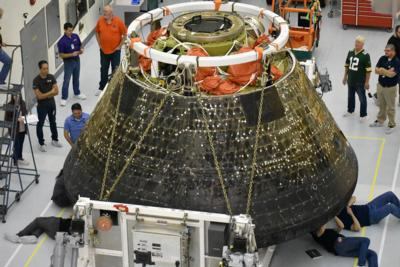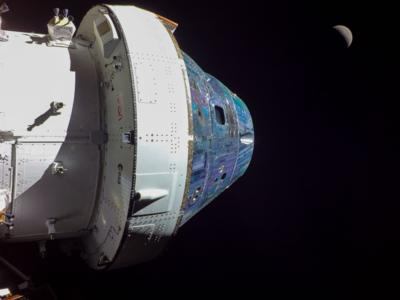Mon, Jan 09, 2023
Heat Shield Inspections Underway on Artemis I Orion
Inside the Multi-Payload Processing Facility at NASA’s Kennedy Space Center in Florida, engineers and technicians are conducting inspections of the heat shield on the Orion spacecraft for the Artemis I mission.

Orion returned to Kennedy on Dec. 30, 2022, after splashing down in the Pacific Ocean on Dec. 11, following a 1.4-million-mile mission beyond the Moon and back.
In the attached photo, technicians underneath the crew module closely examine the heat shield, which endured temperatures near 5,000 degrees Fahrenheit during reentry through Earth’s atmosphere. The heat shield will be removed from the spacecraft and taken to another facility for further detailed inspections.
Teams also are inspecting the windows of the capsule along with the thermal protection on the back shell panels that cover the spacecraft to protect it from the harsh conditions both in space and during the high-speed, high-heat reentry.

On top of the capsule is the deflated crew module uprighting system, which is a group of five air bags that position the capsule right side up after splashdown and were deflated prior to transport back to Kennedy. While still in the transfer aisle of the facility, engineers are in the process of removing external avionics boxes. Technicians will take air samples within the capsule ahead of repositioning it into a service stand that will allow access to the interior. Upon opening the hatch, technicians will remove the internal avionics boxes and payloads. After conducting detailed inspections and testing, the avionics boxes will be reused for the Artemis II mission.
De-servicing will continue in the coming months with the removal of the hazardous commodities that remain on board. Once complete, the spacecraft will journey to NASA Glenn’s Neil A. Armstrong Test Facility for abort-level acoustic vibration and other environmental testing.
More News
Also: Netherlands Donates 18 F16s, 2 737s Collide On Ramp, E-7 Wedgetail Cut, AgEagle's 100th In S Korea The Pilot and Aircraft Privacy Act was introduced in the House by Represent>[...]
Pilot Also Reported That Due To A Fuel Leak, The Auxiliary Fuel Tanks Were Not Used On June 4, 2025, at 13:41 eastern daylight time, a Piper PA-23, N2109P, was substantially damage>[...]
Have A Story That NEEDS To Be Featured On Aero-News? Here’s How To Submit A Story To Our Team Some of the greatest new stories ANN has ever covered have been submitted by our>[...]
From 2023 (YouTube Edition): Reflections on War’s Collective Lessons and Cyclical Nature The exigencies of war ought be colorblind. Inane social-constructs the likes of racis>[...]
What Goes Around, May Yet Come Back Around, Klyde FMI: www.klydemorris.com>[...]
 Airborne 06.30.25: US v ADS-B Misuse, Natl STOL Fire, Volocopter Resumes
Airborne 06.30.25: US v ADS-B Misuse, Natl STOL Fire, Volocopter Resumes NTSB Prelim: Piper PA-23
NTSB Prelim: Piper PA-23 ANN FAQ: Submit a News Story!
ANN FAQ: Submit a News Story! Classic Aero-TV: One Mans Vietnam
Classic Aero-TV: One Mans Vietnam Klyde Morris (06.30.25)
Klyde Morris (06.30.25)




